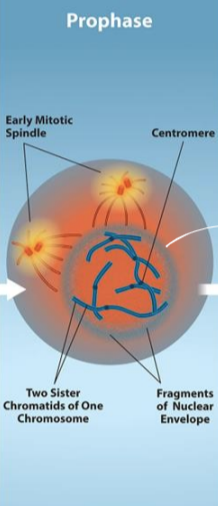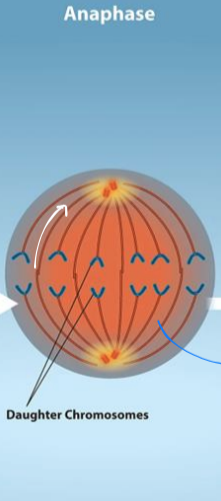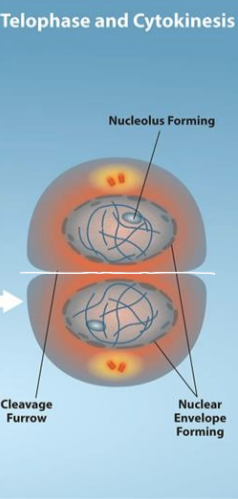Ch 10: Cell Division
1/45
There's no tags or description
Looks like no tags are added yet.
Name | Mastery | Learn | Test | Matching | Spaced |
|---|
No study sessions yet.
46 Terms
what are the 2 functions of cell divisions?
growth, maintenance, and repair of cells and tissues
single-celled organisms use cell division to reproduce
prokaryotic genome
consists of 1 double-stranded circular DNA molecules
resides in nucleoid
additional smaller loops of DNA called plasmids may be present
not necessary for normal growth (non-essential)
may have important information for cell function
exchange of plasmids with other cells allows gene transfer in prokaryotes (in same generation → cell division may not be necessary)
eukaryotic genome
consists of several double-stranded DNA molecules in the form of chromosomes
stored in nucleus
the number of chromosomes in the cell nucleus varies among _______
species
true or false. within a species, chromosome number is consistent, but may vary with developmental stage or specific cell type
true
somatic cells
typically have 2 matched sets of chromosomes
diploid (2n)
1 set of homologous chromosomes from each parent
nearly completely identical (<1% difference)
X and Y chromosomes are not homologous in humans
heterologus
gametes
have half the number of chromosomes (23)
eggs and sperm cells
haploid (1n)
eukaryotic DNA must be __________ into compact chromosomes to fit into the ________
condensed, nucleus
organization of eukaryotic chromosomes from loose to tight
DNA double helix, DNA wrapped around histone, nucleosomes coiled into a chromatin fiber, further condensation of chromatin, duplicated chromosome
which is accessible: euchromatin or heterochromatin?
euchromatin
packaging of eukaryotic chromosomes
short stretches of DNA wrap around a core of 8 histone proteins
histone DNA complex and connecting DNA (string)
this structure coils to form a chromatin fiber
fibrous proteins further pack each chromosome
histone DNA complex
nucleosome
connecting DNA (string)
linker DNA
true or false. eukaryotic DNA must be condensed into compact chromosomes to fit into the nucleus
true
how much DNA is a cell?
6 ft
cell cycle order:
G1, S, G2, Mitosis, Cytokinesis
cell cycle 2 major phases
interphase and mitotic phase
interphase has 3 parts
G1, S, G2
G1 Phase (first gap)
change is not evident but cell is accumulating resources and energy
S Phase - DNA synthesis occurs
identical copies of DNA molecules (sister chromatids) are joined at the centromere fibers
centrosomes produce mitotic spindles to move chromosomes
in animal cells centrosomes are associated with centrioles
help organize cell division
G2 Phase (second gap)
energy is replenished
organelles reproduce and cytoskeleton breaks down
what is the first step in the mitotic phase?
karyokinesis: nuclear division
what is the second step in mitotic phase
cytokinesis: cytoplasmic components physically separate into 2 daughter cells
prophase
nuclear envelope breaks down
membranous organelles (ex. golgi complex, endoplasmic reticulum) disperse to edge of cell
nucleolus disappears
centrosomes being migration to poles
microtubules of spindle form and push apart
sister chromatids coil tighter
aided by condensin proteins

what stage does the nuclear envelope break down?
prophase
what stage do the membranous organelles disperse to the edge of the cell?
prophase
what stage does the nucleolus disappear?
prophase
what stage do centrosomes begin migration to poles, microtubules of spindle form push apart, and sister chromatids coil tighter?
prophase
prometaphase
sister chromatids develop a protein kinetochore in the centromeric region
attaches chromatids to spindle microtubules
polar microtubules contribute to cell elongation

what causes the cell to elongate in prometaphase?
the overlapping microtubules interacting with each other
what stage do the sister chromatids develop a protein kinetochore in the centromeric region?
prometaphase
what stage do the polar microtubules contribute to cell elongation?
prometaphase
metaphase
chromosomes line up along metaphase plate
sister chromatids remain attached by cohesion proteins
maximally condensed

what stage do the chromosomes line up along the metaphase plate?
metaphase
in what stage are the sister chromatids still attached by cohesin proteins?
metaphase
anaphase
cohesin proteins degenerate
chromatids separate
separated sister chromatids move in opposite directions toward centrosomes
cell elongates

what stage do cohesin proteins degenerate and chromatids separate?
anaphase
what stage do the separated sister chromatids move in opposite directions toward the centrosomes, making the cell elongate?
anaphase
telophase
chromosomes reach opposite poles and begin to decondense
spindles depolymerize into tubulin monomers that will form cytoskeletal repurposed components for daughter cells
nuclear envelopes form around the chromosomes
nucleosomes appear within the nuclear area

what stage do the chromosomes reach opposite poles and begin decondense?
telophase
what stage do the spindles depolymerize into tubulin monomers that will form cytoskeletal repurposed components for daughter cells
telophase
what stage does the nuclear envelope form around the chromosomes and nucleosomes appear within the nuclear area?
telophase
cytokinesis in animal cell
forms cleavage furrow to separate into 2 daughter cells
cleavage furrow contains actin filament
cytokinesis in plant cell
vesicles forming cell plate → wall to create 2 daughter cells
G0 Phase
cells not actively preparing to divide (quiescent)
influenced by environmental or growth factors
cardiac muscle cells and central nervous system cells remain here permanently